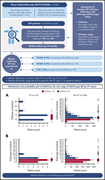Issue Archive
Table of Contents
BLOOD COMMENTARIES
BLOOD SPOTLIGHT
The TEMPI syndrome
Clinical Trials & Observations
In this Blood Spotlight, Sykes et al describe the clinical features and therapy of this rare monoclonal gammopathy and discuss what is known and unknown about its pathophysiology.
CLINICAL TRIALS AND OBSERVATIONS
Acalabrutinib monotherapy in patients with relapsed/refractory chronic lymphocytic leukemia: updated phase 2 results
Clinical Trials & Observations
Byrd and colleagues report follow-up (median, 41 months) results for a phase 1/2 trial of acalabrutinib treatment for patients with relapsed chronic lymphocytic leukemia. Their data on pharmacodynamics and immune reconstitution complement updated summaries of persistence, safety, and efficacy.
Baseline SUVmax did not predict histological transformation in follicular lymphoma in the phase 3 GALLIUM study
Clinical Trials & Observations
Brief Report
For patients with follicular lymphoma being staged with positron-emission scanning before first-line therapy, the finding of lesions with high avidity often triggers concerns about the presence of transformed disease. This study reports that high avidity is not associated with a high risk of transformation during or following standard therapy.
HEMATOPOIESIS AND STEM CELLS
Clonal tracking in gene therapy patients reveals a diversity of human hematopoietic differentiation programs
Six and colleagues report their analyses of long-term hematopoesis in 2 gene therapy trials, enumerating repopulating stem and progenitor cell numbers and deducing their differentiation potential based on clone tracking and novel bioinformatic approaches.
IMMUNOBIOLOGY AND IMMUNOTHERAPY
A T-cell–redirecting bispecific G-protein–coupled receptor class 5 member D x CD3 antibody to treat multiple myeloma
Pillarisetti and colleagues report preclinical validation of the orphan surface receptor GPRC5D as a potential target for T-cell mediated therapy in myeloma. Using cell lines and primary cells, they also provide a comprehensive in vitro and in vivo evaluation of a novel bispecific antibody designed to achieve this.
LYMPHOID NEOPLASIA
CD49d promotes disease progression in chronic lymphocytic leukemia: new insights from CD49d bimodal expression
CD49d positivity in >30% of cells by flow cytometry is a recognized negative prognostic marker in patients with chronic lymphocytic leukemia (CLL). Tissino and colleagues report that in patients with CD49b-negative CLL, the presence of small subclones of CD49b highly expressing cells is sufficient to accord a similarly adverse prognosis with either chemo-immunotherapy or ibrutinib therapy.
MYELOID NEOPLASIA
Mechanistic basis and efficacy of targeting the β-catenin–TCF7L2–JMJD6–c-Myc axis to overcome resistance to BET inhibitors
Secondary acute myeloid leukemia in patients with myeloproliferative neoplasms is a fraught clinical scenario, requiring new therapeutic options. Saenz et al report mechanisms of adaptive and innate resistance to BET inhibition and how rational combination with a disruptor of β-catenin signaling can avert this, generating encouraging in vivo activity in preclinical models.
THROMBOSIS AND HEMOSTASIS
Recognition of PF4-VWF complexes by heparin-induced thrombocytopenia antibodies contributes to thrombus propagation
Johnston and colleagues demonstrated assembly of heparin-induced thrombocytopenia (HIT) immune complexes along von Willebrand factor (VWF) strings released by injured endothelium. This helps explain arterial thrombosis in HIT and suggests that disruption of platelet factor 4–von Willebrand factor (PF4-VWF) complex formation may provide a new therapeutic approach.
Acetylsalicylic acid inhibits intravascular coagulation during Staphylococcus aureus–induced sepsis in mice
Brief Report
Carestia and colleagues report that mice treated with aspirin have significantly reduced platelet aggregation and neutrophil extracellular trap release during Staphylococcus aureus infection. Furthermore, aspirin reduces intravascular thrombin activity, microvascular occlusion, and organ damage.
TRANSPLANTATION
Immune profile differences between chronic GVHD and late acute GVHD: results of the ABLE/PBMTC 1202 studies
Clinical Trials & Observations
Distinguishing between late acute graft-versus-host-disease (GVHD) and chronic GVHD is challenging. Schultz et al report comprehensive immune profiling at day 100 posttransplant and demonstrate how this can distinguish the two, opening avenues for further investigations into their respective biologies.
LETTER TO BLOOD
Diagnostic bone marrow biopsy in patients with stage I EMZL treated with radiation therapy: needed or not?
Clinical Trials & Observations
BLOOD WORK
-
Cover Image
Cover Image
![issue cover]()
This intravital image of mouse liver after Staphylococcus aureus infection reveals robust inflammation involving neutrophils (yellow) and platelets (red), resulting in the release of neutrophil extracellular traps (cyan). Treatment with acetylsalicylic acid reduces inflammation, attenuating tissue damage while not impacting pathogen clearance. See the article by Carestia et al on page 1281.
- PDF Icon Front MatterFront Matter
- PDF Icon Table of ContentsTable of Contents
- PDF Icon Back MatterBack Matter
- PDF Icon Editorial BoardEditorial Board
Advertisement intended for health care professionals
Email alerts
Advertisement intended for health care professionals













Hotter is not more aggressive: baseline SUVmax in FL
Clinical Trials & Observations